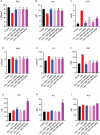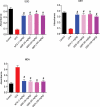Geraniol Suppresses Oxidative Stress, Inflammation, and Interstitial Collagenase to Protect against Inflammatory Arthritis
- PMID: 37841186
- PMCID: PMC10568708
- DOI: 10.1021/acsomega.3c04684
Geraniol Suppresses Oxidative Stress, Inflammation, and Interstitial Collagenase to Protect against Inflammatory Arthritis
Abstract
Geraniol (GER) is a plant-derived acyclic isoprenoid monoterpene that has displayed anti-inflammatory effects in numerous in vivo and in vitro models. This study was therefore designed to evaluate the antiarthritic potential of GER in complete Freund's adjuvant (CFA)-induced inflammatory arthritis (IA) model in rats. IA was induced by intraplantar injection of CFA (0.1 mL), and a week after CFA administration, rats were treated with various doses of methotrexate (MTX; 1 mg/kg) or GER (25, 50, and 100 mg/kg). Treatments were given on every alternate day, and animals were sacrificed on the 35th day. Paw volume, histopathological, hematological, radiographic, and qPCR analyses were performed to analyze the severity of the disease. GER significantly reduced paw edema after 35 days of treatment, and these results were comparable to the MTX-treated group. GER-treated animals displayed a perfect joint structure with minimal inflammation and no signs of cartilage or bone damage. Moreover, GER restored red blood cell and hemoglobin levels, normalized erythrocyte sedimentation rate, platelet, and c-reactive protein values, and also attenuated the levels of rheumatoid factor. RT-qPCR analysis demonstrated that GER decreased mRNA expression of pro-inflammatory cytokines like tumor necrosis factor-alpha (TNF-α) and interleukin-1 beta. GER also down-regulated the transcript levels of cyclooxygenase-2 (COX-2), microsomal prostaglandin E synthase-1, prostaglandin D2 synthase, and interstitial collagenase (MMP-1). Molecular docking of GER with COX-2, TNF-α, and MMP-1 also revealed that the antiarthritic effects of GER could be due to its direct interactions with these mediators. Based on our findings, it is conceivable that the antiarthritic effects of GER could be attributed to downregulation of pro-inflammatory mediators and protease like MMP-1.
© 2023 The Authors. Published by American Chemical Society.
Conflict of interest statement
The authors declare no competing financial interest.
Figures







Similar articles
-
Cassia absus-mediated upregulation of IL-4, IL-10 and downregulation of IL-1β, IL-6, TNF- α, NF-κB, IFN-γ in CFA-induced arthritis model.Inflammopharmacology. 2023 Jun;31(3):1241-1256. doi: 10.1007/s10787-023-01185-1. Epub 2023 Apr 1. Inflammopharmacology. 2023. PMID: 37005957
-
Novel acetamide derivatives of 2-aminobenzimidazole prevent inflammatory arthritis in rats via suppression of pro-inflammatory mediators.Inflammopharmacology. 2022 Jun;30(3):1005-1019. doi: 10.1007/s10787-022-00969-1. Epub 2022 Apr 16. Inflammopharmacology. 2022. PMID: 35429318
-
Aliskiren, tadalafil, and cinnamaldehyde alleviate joint destruction biomarkers; MMP-3 and RANKL; in complete Freund's adjuvant arthritis model: Downregulation of IL-6/JAK2/STAT3 signaling pathway.Saudi Pharm J. 2020 Sep;28(9):1101-1111. doi: 10.1016/j.jsps.2020.07.011. Epub 2020 Aug 3. Saudi Pharm J. 2020. PMID: 32922141 Free PMC article.
-
Chymotrypsin attenuates adjuvant-induced arthritis by downregulating TLR4, NF-κB, MMP-1, TNF-α, IL-1β, and IL-6 expression in Sprague-Dawley rats.Immunopharmacol Immunotoxicol. 2022 Dec;44(6):959-969. doi: 10.1080/08923973.2022.2093743. Epub 2022 Jul 11. Immunopharmacol Immunotoxicol. 2022. PMID: 35737007
-
Evaluation of the effect of andrographolide and methotrexate combined therapy in complete Freund's adjuvant induced arthritis with reduced hepatotoxicity.Biomed Pharmacother. 2018 Oct;106:637-645. doi: 10.1016/j.biopha.2018.07.001. Epub 2018 Jul 11. Biomed Pharmacother. 2018. PMID: 29990853
Cited by
-
Geraniol Ameliorates Pentylenetetrazol-Induced Epilepsy, Neuroinflammation, and Oxidative Stress via Modulating the GABAergic Tract: In vitro and in vivo studies.Drug Des Devel Ther. 2024 Dec 5;18:5655-5672. doi: 10.2147/DDDT.S481985. eCollection 2024. Drug Des Devel Ther. 2024. PMID: 39654600 Free PMC article.
-
Linalool and Geraniol Defend Neurons from Oxidative Stress, Inflammation, and Iron Accumulation in In Vitro Parkinson's Models.Antioxidants (Basel). 2024 Jul 29;13(8):917. doi: 10.3390/antiox13080917. Antioxidants (Basel). 2024. PMID: 39199163 Free PMC article.
-
Genotoxic and Anti-Genotoxic Potential of Hydrosols from Water-Steam Distillation of Oil-Bearing Roses Rosa centifolia L. and Rosa gallica L. from Bulgaria.Pharmaceuticals (Basel). 2024 May 20;17(5):657. doi: 10.3390/ph17050657. Pharmaceuticals (Basel). 2024. PMID: 38794227 Free PMC article.
-
Determination of nine prostaglandins in the arachidonic acid metabolic pathway with UHPLC-QQQ-MS/MS and application to in vitro and in vivo inflammation models.Front Pharmacol. 2025 May 30;16:1595059. doi: 10.3389/fphar.2025.1595059. eCollection 2025. Front Pharmacol. 2025. PMID: 40520189 Free PMC article.
-
Plant Monoterpenes and Essential Oils as Potential Anti-Ageing Agents: Insights from Preclinical Data.Biomedicines. 2024 Feb 4;12(2):365. doi: 10.3390/biomedicines12020365. Biomedicines. 2024. PMID: 38397967 Free PMC article. Review.
References
-
- El-Mashharawi H.; Alshawwa I.; Elkahlout M.; Abu-Naser S. An Expert System for Arthritis Diseases Diagnosis Using SL5 Object. Int. J. Acad. Health Med. Res. 2019, 3 (4), 28–35.
-
- Szekanecz Z.; Pakozdi A.; Szentpetery A.; Besenyei T.; Koch A. E. Chemokines and angiogenesis in rheumatoid arthritis. Front. Biosci. 2009, 1 (1), 44–51. 10.2741/E5. - DOI - PMC - PubMed
- Klareskog L.; Ronnelid J.; Lundberg K.; Padyukov L.; Alfredsson L. Immunity to citrullinated proteins in rheumatoid arrthritis. Annu. Rev. Immunol. 2008, 26, 651–675. 10.1146/annurev.immunol.26.021607.090244. - DOI - PubMed
-
- Kinne R. W.; Brauer R.; Stuhlmuller B.; Palombo-Kinne E.; Burmester G. R. Macrophages in rheumatoid arthritis. Arthritis Res. 2000, 2 (3), 189–202. 10.1186/ar86. - DOI - PMC - PubMed
- Deleuran B. W.; Chu C. Q.; Field M.; Brennan F. M.; Mitchell T.; Feldmann M.; Maini R. N. Localization of tumor necrosis factor receptors in the synovial tissue and cartilage-pannus junction in patients with rheumatoid arthritis. Implications for local actions of tumor necrosis factor alpha. Arthritis Rheum. 1992, 35 (10), 1170–1178. 10.1002/art.1780351009. - DOI - PubMed
- Gravallese E. M. Bone destruction in arthritis. Ann. Rheum. Dis. 2002, 61 (Suppl 2), ii84–86. 10.1136/ard.61.suppl_2.ii84. - DOI - PMC - PubMed
LinkOut - more resources
Full Text Sources
Research Materials

